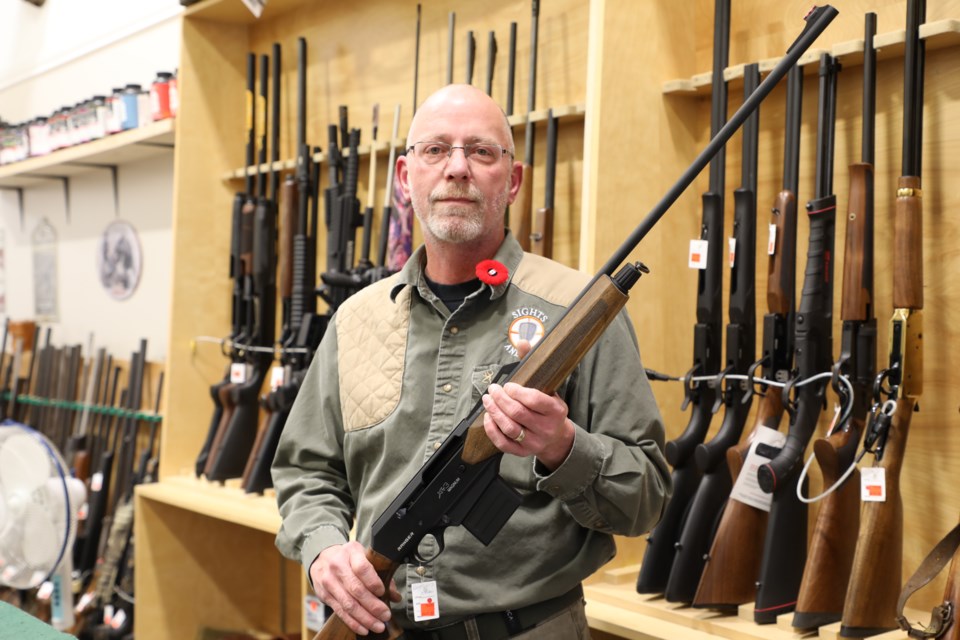He rebuilt his first single-shot .22 when he was 13 years old and Randy Simonneau has been working with guns ever since. Unsurprisingly, Simonneau, like many Albertan gun owners, has some strong words about the federal government's most recent gun ban.
“Everybody's just calling bull on the whole thing. It's a boondoggle,” said Simonneau, gunsmith and part-owner of Sights and Arms Ltd, a gun shop in St. Albert.
The Alberta Firearms Advisory Committee is welcoming anyone with an opinion on firearms to voice their concerns until Dec. 6. The government is hosting two online townhalls and is inviting Albertans to take part in an online survey about firearms policy. One town hall took place Tuesday evening and the second is set for Nov. 23.
The committee was established back in June to study the impact of a federal ban on firearms owners and to look at how provincial policies can best be suited to the needs of Albertans. The move came after the federal government banned more than 1,500 types of firearms in May.
Simonneau has already completed the survey and plans to take part in a town hall.“You know, I'll be honest with you, I don't know what the goal of the chat is going to be. I'm more curious to see what's going to be brought to the table,” he said.
The committee is tasked to set up a provincial firearms office and eventually appoint a firearms chief to oversee federal law. The government plans to have this finished sometime in the next year.
There are already five provinces that have their own firearms chief: Ontario, Quebec, Prince Edward Island, Nova Scotia and New Brunswick. Having a provincial firearms chief would mean that there would be provincial administration over the firearms act.
“I think it's excellent because it's going to add local representation, if you will, because they'll understand what it's like to live and hunt and have firearms in Alberta,” Simonneau said. “Whereas, take the metropolitan city, Toronto, they have a whole different outlook on it. We have a whole different outlook here.”
Dane Lloyd, Conservative MP for Sturgeon River-Parkland, thinks the province is heading in the right direction.
“I think the province is stepping up. People in Alberta have a very different perspective from Ottawa and they want to see their provincial government step up in any way that it can to protect law-abiding firearm owners,” Lloyd said.
Lloyd said his constituents, both men and women, have been very vocal about the ban. Firearm issues are one of the top five issues in his constituency.
One of their biggest problem with the ban is that it doesn’t make sense, he said. He believes many of the guns banned are banned because of appearance.
“Law-abiding people don’t have 30-round magazines or high-capacity magazines, they don’t have fully automatic firearms,” he said. “But what they do have, occasionally, are firearms that might look – and this is a cosmetic thing – they cosmetically look like police or a military-style firearm.”
Simonneau thinks the ban is senseless for the same reason. The semi-auto .410 Ranger XT3 shotgun is banned in the colour black but its brown sister version has not been banned. He thinks that's because the black version looks more like a tactical weapon.
He also pointed out a Yugoslavian grenade launcher, which under current legislation, is legal.
“So that's not banned. It wasn't talked about. There's no explanation for it,” said Simonneau.
The federal ban came in response to the Nova Scotia mass shooting that took place in April. Gun advocates were angry about the ban because the guns used in the attack were not legal firearms.
However, not everyone disagrees with the federal ban. Dr John Kortbeek, a trauma surgeon in Calgary and advocate with Doctors For Protection Against Guns, said in the three decades that he has practiced he has seen tremendous improvements to the quality of care but he has also seen an increase of gun incidents. What was once a rare event, has become fairly common.
Kortbeek said they do see a lot of gang-related injuries, but they also see injuries from people who were unlucky enough to be in the wrong place at the wrong time.
“What I see in my practice? I see everything. I see people that are shot with legally purchased handguns, I see people that are victims of crime – where the weapon potentially was illegal or stolen. I see victims, again, gang violence. I’ve seen all those things,” he said.
He supports the federal legislation and believes an increase in handguns and assault weapons increases violence in communities.
He isn’t sure what is driving the provincial government’s agenda on the federal firearm ban.
“The polling data is in the public domain. The evidence for eliminating those weapons comes from other countries that have done it.”




